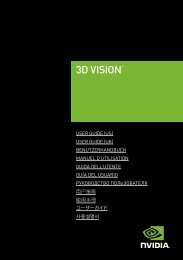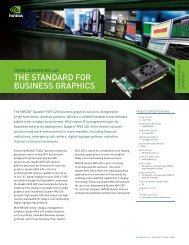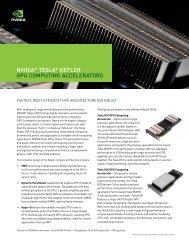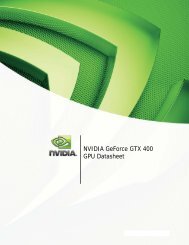Tegra 4 Whitepaper - Nvidia
Tegra 4 Whitepaper - Nvidia
Tegra 4 Whitepaper - Nvidia
- No tags were found...
Create successful ePaper yourself
Turn your PDF publications into a flip-book with our unique Google optimized e-Paper software.
P a g e | 6because they should not be rendered. Edge and plane equations are calculated on theprimitives in preparation for rasterizing.Figure 2 – <strong>Tegra</strong> 4 Logical Graphics Processing PipelineThe Rasterizer converts primitives to pixels fragments to feed the pixel shader pipelines, andthe Early-Z unit can reject pixels that have depth (Z) values that would place them behind pixelsalready in the framebuffer. Pixel Shader pipes then operate on pixel fragments that pass the Z-test by running pixel shader programs on each pixel fragment. A programmable blend stage isincorporated in the Pixel Shader allowing any type of blend mode to be implemented, not onlythose found in the OpenGL spec.The Pixel Cache (also called the Fragment Data Cache) caches writes to the framebuffer and isuseful in reducing off-chip framebuffer traffic for user interface pixels or other areas that havehigh reuse, in addition to Early-Z testing.The texture unit fetches and filters texture data to apply to a pixel, and frequently accessedtexture data is cached in both L1 texture caches present in each Texture Unit and in a sharedL2 texture cache that is shared by all four texture units. Finally, the processed pixels can beNVIDIA <strong>Tegra</strong> 4 GPU Architecture February 2013
















